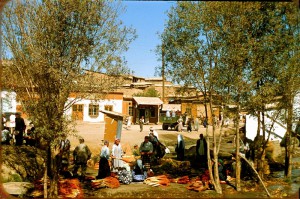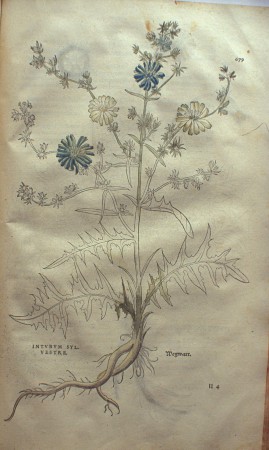- “Organic management practices appear to result in elevated levels of grain micronutrient concentration.” By no means the whole story.
- Tom too takes The Economist to task.
- Afghanistan’s opium growers. Damned if you do, damned if you don’t.
- Nixtamalization for the rest of us. More than you could ever want to know. Rye tortillas!
- Chocolate began with leftover beer? Seems unlikely.
- Take the fight to the monster’s lair. Swap seeds in Brussels. h/t Patrick.
- Dogs or dholes? Yeah I didn’t know what they were either.
- There was a workshop on “Seed System and Climate Change” in Bhutan a month ago.
- Big biofuel project in Tanzania bites the dust. And the land they “leased,” what happened to that?
- Ancient grinding holes. Might mesquite be another edible never domesticated?
Historical agrobiodiversity photographs online
 I’m not sure why I like old photographs of markets so much, but one reason may be because at the back of my mind is the thought that maybe photos such as the one from Uzbekistan in the 1950s at left and similar ones from 1920s Egypt could be used to gauge genetic erosion. Too bad the metadata for the stock imagery at National Geographic (where the Egypt photographs came from) doesn’t include date. Anyway, speaking of agrobiodiversity photographs from Egypt, the wonderful Saudi Aramco World also has some in its latest issue.
I’m not sure why I like old photographs of markets so much, but one reason may be because at the back of my mind is the thought that maybe photos such as the one from Uzbekistan in the 1950s at left and similar ones from 1920s Egypt could be used to gauge genetic erosion. Too bad the metadata for the stock imagery at National Geographic (where the Egypt photographs came from) doesn’t include date. Anyway, speaking of agrobiodiversity photographs from Egypt, the wonderful Saudi Aramco World also has some in its latest issue.
Nibbles: Cloves in Zanzibar, Invasive species, Fingerprinting genebanks, Seed ownership, Pollinator photography, Columbids
- Clovefield.
- They Eat Invasives, Don’t They?
- The Wrong Seeds.
- Seeds of One’s Own.
- Bee Photographs.
- Clay Pigeons.
Ancient wild relatives
While we’re on the subject of radicchio diversity, old Roman medicines and the like, we were pleased to be sent a link to Renaissance Herbals, a collaboration between the Smithsonian Institution and the Biblioteca Nazionale Centrale di Roma. There are some lovely images to peruse and use, like this one, of wild chicory, Cichorium intybus.:

One could complain, of course, that the links between the illustrations and other sorts of information are non-existent. But hey, you can’t have everything.
More on ancient Roman pills
What I missed when I wrote about the 2000-year-old Roman pills a couple of days back is that the research was highlighted by Discover magazine as one of the Top 100 Stories of 2010. In addition, Emanuela Appetiti, one of the researchers involved, kindly pointed me to a story at AoLNews which has lots more photos and another one in the Washington Post. She also gave me this nice bit of news:
…I am happy to inform you that Alain Touwaide and myself, along with Rob Fleischer, the geneticist who did the DNA analysis of the ancient medicines, will be in Rome in mid-May 2011 (on the occasion of the “Night of the Museums”) to present at “La Sapienza” University this research. For the first time, we’ll be all there: the three of us and the staff of the Soprintendenza di Firenze, who did the archeaological digging and first analysis. The event in Rome will be on May 14, 2011, at the faculty of Letters.
Looking forward to that. In the meantime, here’s a very recent interview with Alain Touwaide, courtesy of the BBC. Thanks, Emanuela.